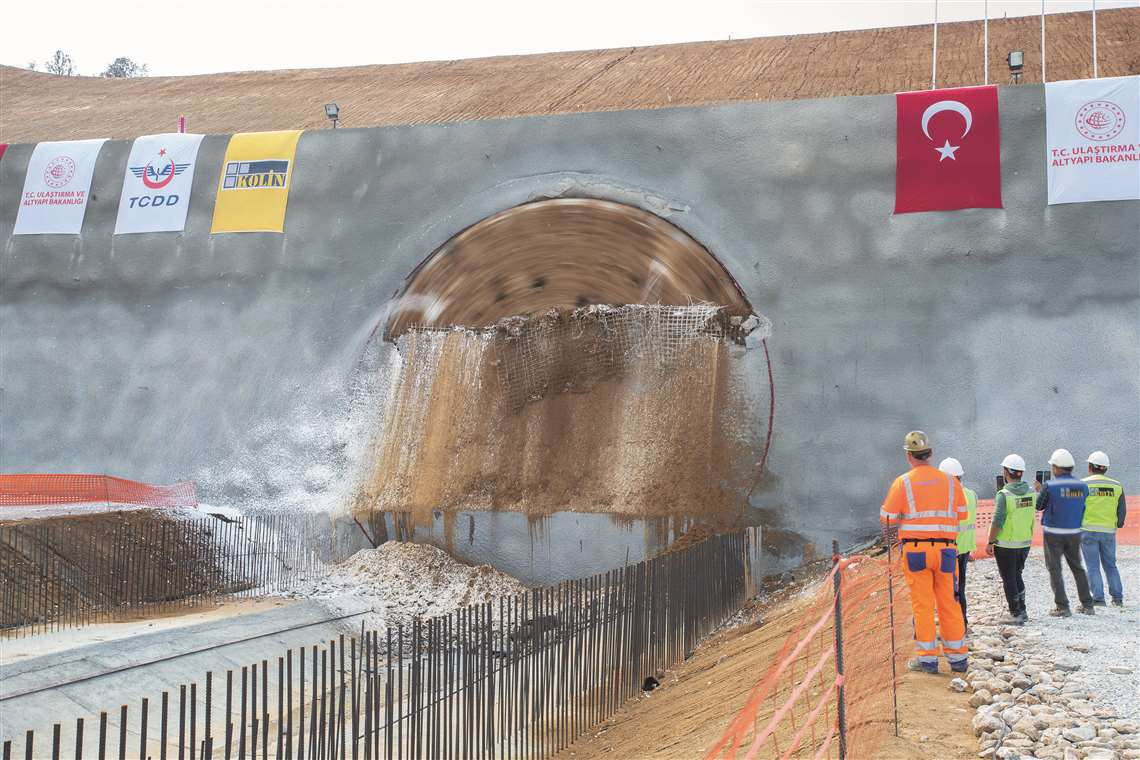Europe’s most impressive tunnel projects
25 January 2022
With new infrastructure spending set to result in more tunnelling projects across Europe, Leila Steed reports on the industry’s latest projects.
Of all the activities encompassed within the construction sector, tunnelling is known for being among the most technically complex, expensive and dangerous of undertakings.
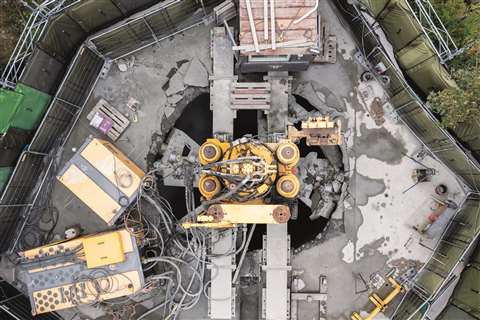 Master Drilling’s raiseboring rig pulls up the reamer head that bores the vertical shaft. ©Master Drilling/Kasper Dudzik
Master Drilling’s raiseboring rig pulls up the reamer head that bores the vertical shaft. ©Master Drilling/Kasper Dudzik
While the demands and challenges inherent in the sector means the actual building of tunnels is a notoriously slow process – as evidenced by the daily progress of tunnel boring machines (TBMs) usually measured in feet and inches rather than metres – the most recent tunnelling projects across Europe are breaking new ground in more ways than one.
Raiseboring
Take Master Drilling Europe’s recent work on the West Link infrastructure project in Gothenburg, Sweden, for example.
Also known as “Västlänken”, the project includes the construction of a 6km long underground railway tunnel and three new train stations, which upon completion will connect commuter routes throughout the city.
In October of this year, Master Drilling completed the excavation of a 66m long vertical tunnel for the city’s new Haga Station, using the raiseboring method – an unusual choice of method given that the shaft measured 6.6m in diameter.
“Here is the thing, this shaft is actually very big. Traditionally raiseboring is not done so big,” says Joakim Furtenback, General Manager at Master Drilling Europe.
While raiseboring has been used in the mining sector for a long time; to create tunnels typically measuring between 2m and 4m, it is rare for the method to be used for urban infrastructure projects – and even rarer for the construction of such a large tunnel.
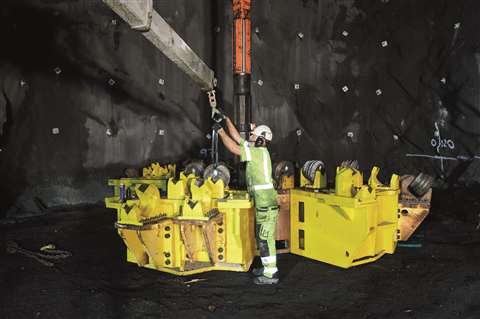 Master Drilling’s 44.2 tonne reamer head is equipped with cutters and pulled up by the raiseboring rig, situated above ground. ©Master Drilling/ Tommy Hvitfeldt
Master Drilling’s 44.2 tonne reamer head is equipped with cutters and pulled up by the raiseboring rig, situated above ground. ©Master Drilling/ Tommy Hvitfeldt
The process saw the company install a raiseboring drill rig on a concrete pad at surface level. With the rig surrounded by fences equipped with soundproofing, Bergteamet began by drilling a pilot hole down from the surface into a newly excavated tunnel below.
Once the pilot bit had penetrated the roof of the tunnel below, the company then removed the pilot bit from the rig and connected a 6.6m diameter, 44.2 tonne reamer head equipped with cutters.
With the reamer head pushed up against the ceiling of the tunnel and, using a rotating motion, it carved out the tunnel as the rig pulled it up through the ground to the surface.
“All the debris will just fall down by gravity between the wings so it will come down to the bottom of the tunnel and all the loading will be done at the bottom of the tunnel,” explains Joakim.
“It’s quite impressive actually. It’s a lot of tonnes – just the weight of the reamer and the weight of the rods, and then on top of that the pressure you need to apply to the rock… It’s hundreds of tonnes of force.”
Joakim says, “A lot of people have seen this in the infrastructure business – I mean contractors around the world are asking us ‘why did you use this method? Why did you not use the conventional drill and blast - or use excavators with rock breakers?’
The simple answer is that the raiseboring method offered several advantages over other tunnelling methods.
“Typically the shafts that are being developed at stations like this on construction job sites are, most of the time, top-down demolitions of the shaft, using excavating or even using explosives sometimes,” says Joakim.
“But in the city centres the noise level – also the cracks that you get in the building and the rock when you do blasting is not the preferred method. And also you have dust, vibrations…all those things.”
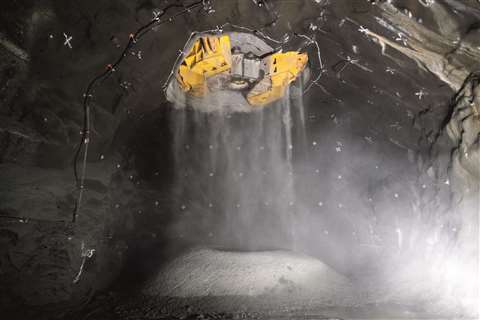 It took Sweden-based Master Drilling Europe 48 days to bore the 6.6m diameter shaft. ©Master Drilling/Kasper Dudzik
It took Sweden-based Master Drilling Europe 48 days to bore the 6.6m diameter shaft. ©Master Drilling/Kasper Dudzik
With the construction site being located less than 75m from a number of apartment blocks and less than 100m from a nursery school, the raiseboring method enabled the company to excavate the tunnel without any noise or percussion.
Joakim says, “When you start the piloting, as soon as the pilot bit is maybe one or two metres underground then there is just rotating and water.”
“There is no percussion. So there is basically no noise level and the machine itself operates from electricity on the surface.
“And even when you start from the bottom with the reamer, you start at 70m deep and you pull the reamer up to the top, so again there is no vibration and no noise at all from this method, which is a great advantage in city centres.”
The 66m long vertical tunnel was completed in less than three months, and while Master Drilling was not looking to break any speed records, others in Europe have.
Tunnel boring projects
Take the TBM deployed on the 3.05km long Esme-Salihli Railway Tunnel in Turkey for example.
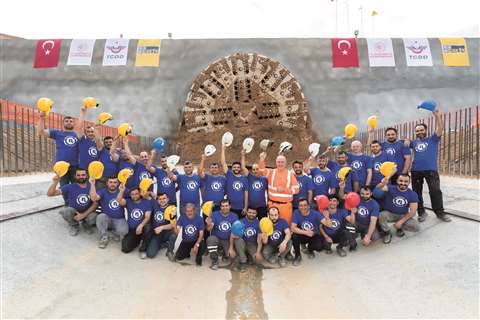 Personnel from Kolin Construction and Robbins celebrate the breakthrough of a Crossover XRE TBM after it completed Turkey’s Esme-Salihli Railway Tunnel.
Personnel from Kolin Construction and Robbins celebrate the breakthrough of a Crossover XRE TBM after it completed Turkey’s Esme-Salihli Railway Tunnel.
Manufactured by US-based specialist Robbins, the 13.7m diameter Crossover XRE TBM recently set new records for the most amount of tunnel bored in a single day, week and month.
It excavated distances of 32.4m on its best day, 178.2m over the course of its best week and achieved a best month distance of 721.8m, beating the records it had previously set in May and June.
Designed to work in ground that comprises a mixture of hard rock, soft soils and boulders, Robbins says the machine’s large diameter enables both a screw conveyor and belt conveyor to remain in place.
This allows it to operate in different modes according to the ground type and to quickly change between modes.
The excavation of the Esme-Salihli Railway Tunnel, which forms part of the new 508km long Ankara-İzmir High Speed Railway being built by Turkish State Railways on the country’ west coast, began in March 2021.
It saw the Crossover XRE TBM bore through sandstone, gravelstone, claystone, quartz and siltstone, before breaking through its end point just last month.
While this has led the TBM to be dubbed the fastest in the world for this diameter class, Onur Kansu, TBM manager for project contractor Kolin Construction, says, “The most important reason for achieving fast advance rates is that we have an experienced and qualified team.
“Such a team allows us to anticipate the malfunctions and to go to the solution in a very short time.
“In addition, all necessary maintenance is carried out on time, and the appropriate consumables are selected to increase the performance,” Kansu adds.
Brenner Base Tunnel
Similarly, Italian construction giant Webuild also recently celebrated the breakthrough of one its TBMs working on the 65km Brenner Base Tunnel, which is currently under construction beneath the Eastern Alps of the Brenner Pass between Fortezza in Italy and Innsbruck in Austria.
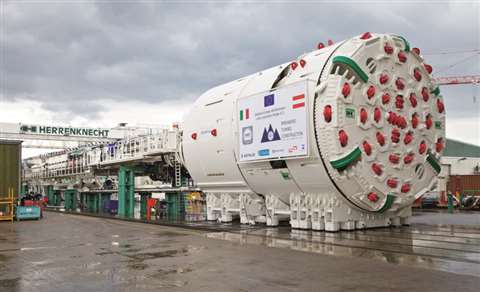 TBM Serena has now completed her three and a half year bore on the Brenner Base Tunnel.
TBM Serena has now completed her three and a half year bore on the Brenner Base Tunnel.
The TBM, which was built by German manufacturer Herrenknecht and is named Serena, completed the excavation of a 14km exploratory tunnel on the Italian side of the Brenner Base Tunnel.
It took the double shield machine three and a half years to complete the task, which represents just over 80% of Webuild’s excavation work on Lot Mules 2-3.
Adding to its work on the project, last month Webuild and its Swiss subsidiary CSC also won the contract for Lot H41 Gola del Sill‐ Pfons on the Brenner Base Tunnel.
Valued at €651 million, the contract is for a section of railway tunnel on the Austrian side of the Alps. The works will see the construction of two 7.3km long parallel tunnels – including auxiliary tunnels – using traditional methods, as well as the excavation of another 16.5km tunnel using TBMs.
Webuild and SCS will use two TMBs with diameters of over 10m to carry out the works, which include the lining of the completed tunnels, the construction of access tunnels, exploratory tunnels and the building of an underground emergency stop at Innsbruck.
Prior to this latest contract award, the Italian construction and engineering group also secured a €1.07 billion contract to build the 22.5km railway line extending from the southern end of the Brenner Base Tunnel.
Commissioned by the Italian railway infrastructure management company Rete Ferroviaria Italiana, Webuild will be responsible for the design and construction of the line between Fortezza and Ponte Gardena on the Italian side of the Alps.
Taking place predominantly underground, the project will include not only the track, but also a number of underground interconnections and additional works at Ponte Gardena.
Likewise, another major infrastructure project in Europe is also speeding ahead.
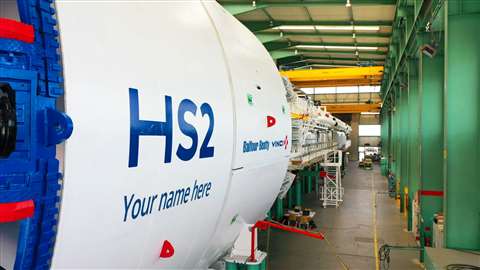 Dorothy’s name was chosen by local residents and school children via a competition.
Dorothy’s name was chosen by local residents and school children via a competition.
HS2 update: TBM launch
Just a few weeks ago, a 2,000-tonne tunnelling boring machine named Dorothy was launched in the West Midlands region, as part of works to build the new High Speed 2 (HS2) railway in the UK.
The 125-metre-long machine, which was built and assembled by 170 engineers, set off from the north portal of the under-construction Chiltern Tunnel in Warwickshire. It is the first TBM to be launched on the Midlands section of HS2.
Named after Dorothy Hodgkin - the first British woman to win a Nobel Prize for Chemistry – the TBM will excavate a one-mile twin bore tunnel that runs under Long Itchington Wood.
Dubbed the Long Itchington Wood Tunnel, its construction will preserve an ancient woodland aboveground, which is classified as a Site of Special Scientific Interest and is home to a complex ecosystem that has evolved over centuries.
HS2 says the final section will form a ‘green tunnel’ - also known as a cut and cover tunnel - where a roof above will return the land to the natural landscape.
“This is yet another vital landmark in our journey towards a better connected Britain and with the launching of Dorothy today in Warwickshire, shows real progress in helping transform journeys across our country,” says Andrew Stephenson, Department for Transport Minister of State for HS2.
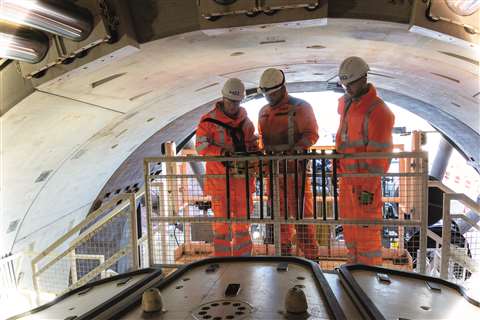 HS2 CEO Mark Thurston pushes the button to start TBM Dorothy on her HS2 journey.
HS2 CEO Mark Thurston pushes the button to start TBM Dorothy on her HS2 journey.
Dorothy will be in continuous operation for the next five months and, manned by an “expert tunnelling team” working 24 hours a day in two shifts, she will remove a total of 250,000 cubic metres of mudstone and soil.
The TBM, which was built by Herrenknecht, is currently scheduled to break through the Chiltern Tunnel’s south portal next spring.
After completing the first bore, Dorothy will be disassembled and taken back to her launch site by road, where she will then be reassembled before setting off on the second bore for the twin-tunnel, which is due to be completed in early 2023.
Dorothy is not the first TBM to be launched for the high speed railway project, but with just 1 mile of tunnel to excavate beneath England’s soils, she will be the first to complete her bore.
Her launch comes seven months after that of ‘Florence’ - the largest TBM ever used on a UK rail project - and six months after the launch of Florence’s twin sister machine, Cecilia.
While European tunnelling projects like HS2 will be ongoing for a number a years, increased infrastructure spending by governments to stimulate economic growth in the face of Covid-19 – not to mention the growing need for mass transit systems that can help Europe meet net zero carbon emissions - means the tunnelling sector will likely grow over the next few years.
Sea tunnelsWhile projects like the Brenner Base Tunnel, HS2 and the Ankara-İzmir tunnel aim to improve Europe’s railways, the proposed Stad Ship Tunnel at the western tip of Norway intends to help ships navigate the most exposed stretch of sea on the country’s coast. 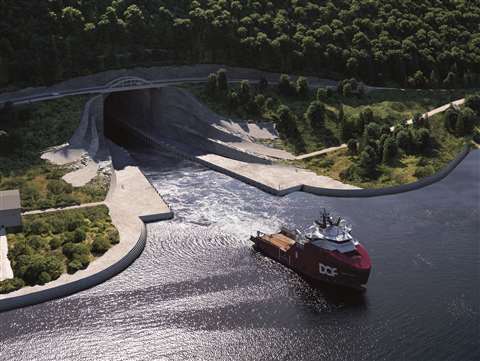
After years of debating the possibility of a tunnel through the mountains of the Stad peninsula the Norwegian government has now provisionally allocated NOK2.7 billion (€265 million) towards a tunnel project based on a revised plan put forward by the Norwegian Coastal Administration (NCA) in 2017, CE’s Mike Hayes reports. The proposed tunnel will measure 1.7km long, 37m high and 26.5m wide – large enough to be safely navigated by ships the size of a coastal steamer. The cross-sectional area of the tunnel will be 1,661m2, and the total volume of rock expected to be removed is approximately 3 million m3 – equivalent to some 8 million tonnes of blasted rock. Construction of the tunnel is likely to be undertaken using conventional blasting methods, utilising underground drilling rigs and pallet rigs. |
Tunnel formworkWhen it came to the construction of the Benta Berri Metro Station for the Lugaritz-Miraconcha section of the new San Sebastian Subway in Spain, contractors chose to use a method of stabilisation normally used in mining. The new Benta Berri Metro Station in the city of Donostia-San Sebastian, which is located on Spain’s north-eastern most coast near the Andorran border, comprises a cavern station with two lateral platforms situated 25m underground. Due the oval-shaped cavern’s dimensions, which come in at 16m wide by 12m tall with a total volume of 14,500m3, its construction required the used of 3,200m2 of formwork. To enable the onsite technicians to pour the concrete for the cavern, which had to be carried out in three separate stages – for the inverted vault, side walls and vault, global formwork pecialist Alsina was contracted to provide a formwork system commonally used in mining. Alsina provided a combination of products for the works, including its Multiform, Circular One-sided Wall, and high-bearing-capacity scaffolding. To enable workers to build the arch of the inverted vault, Alsina supplied “climbing equipment that could adapt to any position with circular formwork”. This allowed 30m2 sections of concrete to be poured each day. Additionally, Alsina provided two 6m moving trolleys that allowed the concrete to be poured up to twice a week for the construction of the inverted vault’s keystone. |
Tunnel liningItalian company William Mosconi is currently using a Magni telehandler to carry out waterproofing works to the underwater section of the 55km long Brenner Base Tunnel. 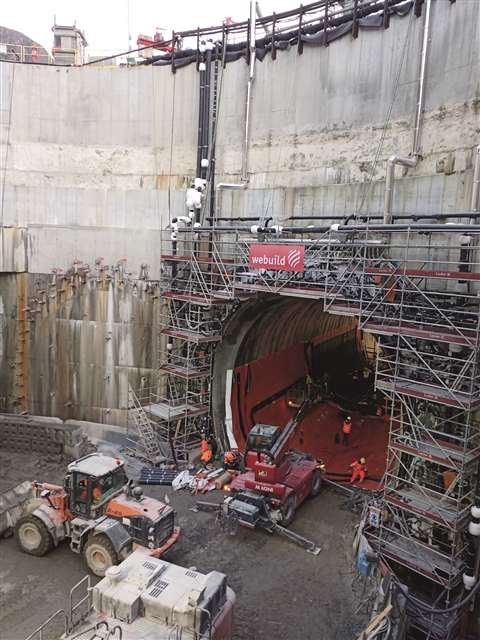
The demolition and waterproofing specialist was contracted by Webuild to hermetically isolate the tunnel section, which runs under the Isarco river, using waterproof PVC membranes to prevent water seepages. William Mosconi, technical director of William Mosconi, says, “This work must be performed at height and once the ribs supporting the vault have been installed. After taking into account different players of the lifting sector, Mosconi decided to entrust Magni with this special project.” The company selected Magni’s twin energy RTH 5.21 SH model for the project, which will see parts of the ground beneath the river frozen to allow construction of the tunnel. The rotating telehandler, which features an electric mode for operation in environments with poorly ventilation, was connected to external electricity supply of 380V. The telescopic model is fitted with a 15kW electric motor and a 90-litre piston pump, and has a maximum lifting height of 21m and an outreach of 15.5m. Capable of lifting 5,000lbs at full height and equipped with two platforms, Mosconi says using the telehandler allows workers to safely reach the height of the vault to install the PVC sheaths. |
Cut-and-cover tunnelsEarlier this year a joint venture company made up of Ferrovial’s construction subsidiary and infrastructure specialist Acciona, won a contract for works to the new Calle-30 tunnel in Madrid, Spain. 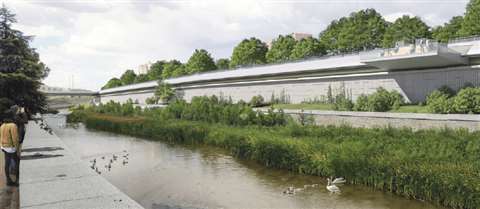
The contract – the value of which was not disclosed – was awarded by Madrid City Council as part of the city’s “Nuevo Mahou-Calderón” road renewal project. The project aims to transform the city’s above-ground M30 motorway into an underground route. The M30 is a major inner-city orbital that measures over 30km long and surrounds Madrid’s central most districts. With much of the works to redirect the route underground already complete, Ferrovial and Acciona’s new Calle-30 tunnel contract covers the last above-ground section of the M30’s southern arc. The Ferrovial-Acciona joint venture will build a 630m-long cut-and-cover tunnel that will be integrated with the adjoining sections of the new Calle-30 tunnel, which have already been built. With varying widths of between 21m at its northern end to 26m at its southern end, the new Calle-30 underground road tunnel will also incorporate the related facilities and services required for its operation and maintenance. These include systems for ventilation, atmospheric conditions detection, radio communications, CCTV and other power and traffic control systems such as a public address system. |
STAY CONNECTED



Receive the information you need when you need it through our world-leading magazines, newsletters and daily briefings.
CONNECT WITH THE TEAM











